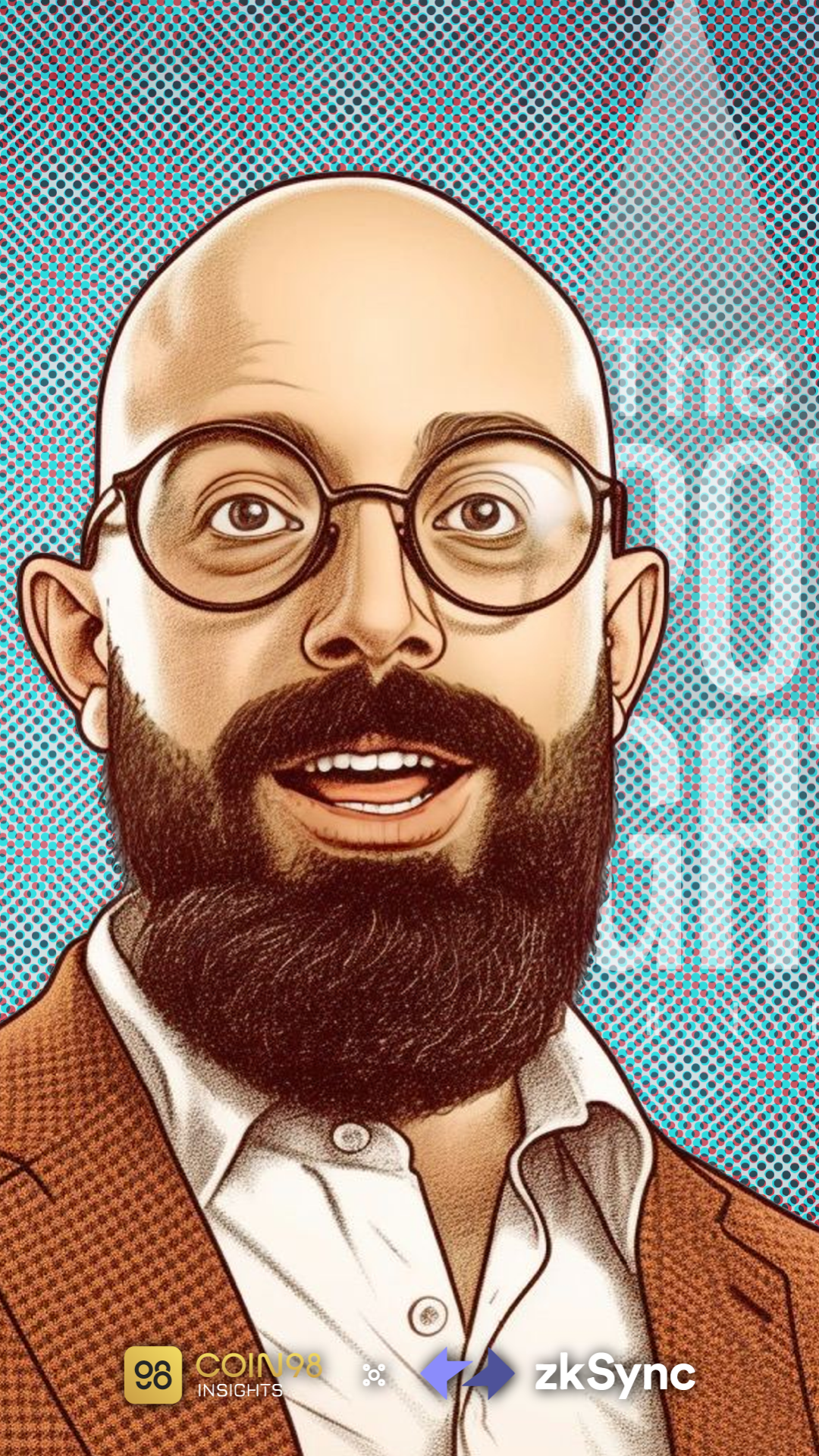ZkSync Era teases token and layer 3 launch

The Spotlight is an exclusive interview series between Coin98 Insights and industry experts on trending topics in the market.
The character in this interview is Omar Azhar, the Head of Business Development at Matter Labs, the company behind the development of the zkSync Era platform.
Matter Labs has successfully raised $458 million from prominent companies, including Dragonfly Capital, a16z, and Blockchain Capital. Their achievements have generated a significant buzz in the summer of 2023, drawing the attention of numerous individuals eager to explore the project.
ZK-rollups: Ethereum's Endgame Scaling Solution
- Hello Azhar. With your background in math and physics, having previously worked at MIT and a large consulting firm before transitioning to machine learning and AI, what led you to crypto?
Azhar: During my time at EY corporation, I worked on solving various problems involving large-scale data in financial services and industries like supply chain and oil and gas. Throughout this experience, I realized that many of these problems couldn't be effectively addressed using Web 2 technology, particularly when it came to coordinating data sharing among different entities.
For example, in the case of banks, sharing customer information such as credit or transaction history to prevent fraud and build credit history requires coordination. However, the inherently centralized nature of Web 2 technology fails to solve this coordination problem.
Blockchain, on the other hand, is capable of addressing these challenges. It was conceived with the purpose of establishing an open ecosystem for secure data sharing and solving coordination problems through its consensus mechanism. This realization prompted me to shift my focus to working with this technology and join Matter Labs.

- Matter Labs is the team behind zkSync, a Layer 2 scaling solution. Could you provide an overview of why Layer 2 solutions are needed?
Azhar: Let's start with the classic blockchain trilemma: security, speed, and decentralization. You can only achieve two out of the three factors, and this presents a trade-off. Blockchain typically prioritizes security and decentralization, as these are the core principles of its inception. Therefore, scalability is achieved through Layer 2, where transactions are processed.
Currently, there are two types of rollups for scaling: Optimistic rollups, which are well-established and mature with leaders like Arbitrum and Optimism, and ZK-rollups, which primarily focus on scaling technology rather than privacy and involve companies like StakeWare, zkSync, Scroll, Polygon zkEVM, and Taiko. Recently, Coinbase launched Base on OP Stack, and ConsenSys introduced a zkEVM called Linea. As evident, numerous networks are competing to solve the scalability problem.
- Speaking specifically about zkSync, why did your company choose ZK-rollups over other solutions?
Azhar: When zkSync was founded three years ago, our founders posed a question: What is the shortest path to Ethereum scaling and crypto adoption?
After considerable contemplation and evaluation of popular options at the time, such as sidechains and Plasma, they believed that these solutions might not be the most direct route. Consequently, they opted for ZK-rollups, a relatively new idea that was projected to take at least another five years to fully materialize.
The underlying logic behind this decision was simple: Why take incremental steps when there is a possibility to progress directly from point A to B? This represents the shortest path. And our founders believed that ZK-rollups could offer that route.
- In particular, what advantages do ZK-rollups possess over Optimistic rollups?
Azhar: ZK-rollups are often regarded as the "endgame" for scaling due to their ability to reduce reliance on trust. They employ cryptography and mathematical constructs, such as zero-knowledge proofs, to authenticate transactions. Currently, the verification process is relatively fast, taking a couple of hours. However, in the future, this duration is expected to decrease to minutes and even seconds.
On the other hand, Optimistic rollups require a verification waiting time of seven days. They initially assume the transactions to be valid, but introduce a timeout period to generate proof of fraud if any transactions are deemed invalid.
For these reasons, ZK-rollups are gaining traction and are being increasingly adopted by companies.

Optimistic rollups vs. ZK-rollups: Horses vs. Cars?
- It has been suggested that protocols will eventually transition to ZK-rollups since sticking with Optimistic rollups is akin to insisting on using horses in the age of cars. What are your thoughts on this?
Azhar: Optimistic rollups are far more advanced than horses. If we consider Ethereum as a horse, Optimistic rollups would be the first generation of cars with significant improvements. Look at what Arbitrum and Optimism are accomplishing. By utilizing these platforms, we can conduct fast transactions at low fees.
However, ZK-rollups can be seen as the next generation of cars—faster, more efficient, and smoother. We can even view this technology as a jet engine.

- As you mentioned, there are numerous scaling solutions in the market currently. How can we address the issue of liquidity fragmentation?
Azhar: Liquidity fragmentation is indeed a challenge. However, it's important to note that it's unlikely for each protocol to own 10% of the total liquidity. The majority of liquidity will be concentrated within the top three protocols, with the remaining protocols accounting for approximately 20% of the liquidity. This helps alleviate some of the liquidity fragmentation. Additionally, several bridges and cross-chain technologies are being developed to support liquidity.
Currently, there is a manual aspect to asset transfers via bridges, requiring users to navigate different networks. However, more and more applications, especially certain wallets, are being built to enable seamless operations on specific chains, even without explicit knowledge of which chain is being used. These wallets provide menus of options for various applications, streamlining processes such as asset bridging.
- Recently, ZkSync Era became the first zkEVM (zkRollup-enabled EVM) in alpha to be available to users, positioning it as the "endgame" for scaling on Ethereum. However, what are your thoughts on the spike in gas fees on the network due to FOMO airdrop users?
Azhar: It is true that rollups are still sensitive to gas fee spikes on Ethereum. To mitigate this, we need to transition more activities from Layer 1 of Ethereum to rollups. This is a natural progression that occurs over time, especially with other optimizations on the horizon, such as EIP-4844, which significantly reduces calldata costs. Typically, the data sent within Ethereum transactions accounts for approximately 90% of the fees. Once we address this, everyone will benefit.
In addition to Layer 2 system updates, we also have Hyperchain, which is essentially the same as zkSync Era but operates as a private chain on top of zkSync. Consequently, solutions like zkPorter or Validium chains can be implemented, further reducing calldata fees.
Summer of zkSync Era
- Given that several protocols adopt ZK-rollups as a scaling solution, what sets zkSync Era apart from Polygon zkEVM and Scroll?
Omar: One notable distinction between zkSync Era and other protocols is the concept of "account abstraction." Many projects leverage this feature to enhance user experience. For instance, with SyncSwap, users can complete swap transactions with a single button press, without the need for approval delays. Mute provides refunds or supports significant transaction fees for specific types of swaps. Tevaera, a gaming app, has an on-chain game ecosystem. Wallets like Argent forego seed phrases and instead rely on multisig activation.
The second difference lies in how data is posted to Ethereum. While Polygon zkEVM and Scroll post all input data, zkSync Era only posts state differences, which benefits users. For regular transactions, users only need to pay for one status update instead of paying for each individual update.
On-chain privacy is another interesting aspect, where the entire zero-knowledge proof does not need to be sent to Layer 1, resulting in significant cost savings for individual transactions.
As the network matures and evolves this summer, these differences will become more apparent.
- Could you elaborate further on how "account abstraction" plays a role in facilitating entry for newcomers to the crypto space?
Azhar: As mentioned earlier, this feature helps create a web experience that users are familiar with. User experience is a significant factor in crypto adoption. Constantly signing transactions while engaging with applications, such as games, can be frustrating. Account abstraction resolves this issue.
Moreover, it removes the barrier of gas fees. When you shop online, you don't have to pay for the Amazon AWS bill of the website you're using; you only pay for the item, sales tax, and shipping costs. In the future, crypto should strive to reach that level, where users don't have to bear associated gas fees.

Additionally, account abstraction facilitates better management. How can we secure wallets? Perhaps through 2FA authentication or integration with a Gmail account. Wallet recovery in case of loss without relying on remembering 12 or 24 seed phrases. Implementing whitelisting, allowing users to trade only with specific sites or setting daily trade limits, is also desirable.
Layer 3 is coming sooner than you think
- Currently, zkSync Era does not have its own token, as the network is still somewhat centralized. Will this change in the future?
Azhar: We prefer not to discuss token matters extensively, but I can say that decentralization is a major priority for us. And as you know, tokens are often necessary to secure a decentralized network.
Currently, we are relatively centralized, and that is not a position we want to maintain in the long term. Therefore, our roadmap involves gradually reducing our dependency on Matter Labs as a Social Layer.
On Ethereum, anyone can operate and join the network as a node. The same will apply to zkSync in the future. Ultimately, the network will be fully community-owned and operated, with Matter Labs no longer acting as a centralized entity.
- zkSync Era has also mentioned Layer 3 quite a bit. Although there is currently no existing version of this new concept on the market, can you provide any insights into when the first Layer 3 will be launched on the mainnet?
Azhar: It is true that there is no current version of Layer 3 available on the market, but it has garnered considerable attention from gaming companies, organizations, banks, and supply companies. While I cannot provide specific details about the launch date, I can assure you that it will arrive sooner than you expect. We have many interesting use cases for Layer 3 that will surprise you.
- Can you share a memorable moment from your time working with zkSync Era?
Azhar: CoinGecko recently published a post comparing the state of various blockchains, including a graph illustrating how quickly platforms reached one million transactions or the first 10,000 to 100,000 users. Interestingly, the zkSync Era chart shot up like a rocket. It was an incredibly memorable moment for me, seeing so many users, transactions, and applications deployed on the network within the first week.
I believe zkSync has experienced the fastest growth relative to any Layer 2 or even public blockchains in terms of user activity. It was a gratifying moment to witness the platform gaining recognition and approval from the ecosystem and the community.